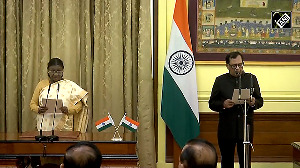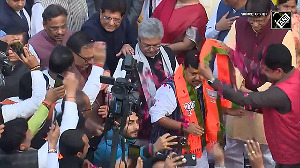Flashback 1985: India had only terrestrial TV channels -- controlled by the government. International magazines came into India weeks after their release abroad. Indians travelled abroad mainly on work -- only the super-rich affording holidays overseas. And foreign brands were prized possessions brought back or imported from abroad.
Cut to 2003: The bombings of Baghdad, the Oscars in LA, the Miss World pageant in London -- are all witnessed live, simultaneously by Indians and their global counterparts. International magazines now have Indian versions.
Foreign holiday travel is now big business in India -- travel agents offering attractive, instalment packages to even far away places like China and New Zealand. (Holidays to South-East Asia are today cheaper than long distance holidays within India). And most foreign brands are now readily available in India.
India has changed. The economic liberalisation in 1991 has brought the world into India, and transformed the life of the consumers in the country.
Foreign direct investment in the country has grown from $97 million in 1990-91 to $3,905 million in 2001-2002, being over $2,000 million every year since 1995-96. And India is seen as a potential big market for numerous companies abroad -- China, the only other market, being rated higher and bigger.
Simultaneously the Indian consumer has globalised -- in thinking and in living. Three factors have contributed to this globalisation.
1. Media: Satellite television has brought the western world into the Indian homes. And thus exposed the average Indian to new lifestyles. Subliminally, many erstwhile taboos (e.g. dress) have been broken and newer styles made acceptable.
In fact, channels like MTV and Channel V, have actually brought the teenagers in metros and small towns closer together -- their aspirations and icons are the same.
2. Travel: As more and more Indians go out of the country for study, work and leisure, the Indian is exposed to and gets first hand experience of a world and life, which is different from what he has in India.
Thus bringing back those ideas and expectations into this country and into his life here. Suddenly his world-view is no longer dictated by his town or country, but the globe!
3. Brands: The sheer entry and presence of international brands in this country over the last decade has created a paradigm shift in the availability and accessibility of products and services in the country.
And this has automatically resulted in a quantum jump in the standards of quality and style. A car market that had just 3 brands in the 80s, has nearly 20 brands today jostling for mindshare.
And the entry of fast food service brands like McDonalds and Pizza Hut have redefined service expectations.
Thus the Indian consumer's awareness, knowledge and desires are driven by a larger canvas than by what's just there in India. Does this mean he is now one more member of a global market?
With a population of 1 billion (one-sixth of the world's), the key question for marketers is whether India has become part of a global mass or is a distinct segment within that global mass.
The quest for global solutions will always remain attractive. Two realities drive it.
Practical reality: The temptation of economy of scale is hard to resist. As a brand moves from market to market, there is a tendency to avoid reinventing the wheel and draw on mixes and lessons from the existing market and transpose it into a new market.
Conceptual reality: In the end, we are all human beings with the same basic motivations. Maslow reduced them to five basic drives -- sustenance, security, social, self-image and self-actualisation.
Interestingly, all product markets -- tea to liquor to paint to cars -- can be reduced to four basic segments -- price conscious, value seeking, status conscious and connoisseur.
The globalist will argue that had India not been integrated into one country by Sardar Patel in 1948, we would have perhaps been debating today whether a unified brand or communication would be possible for the multiple countries that India could have become.
On the other hand, 50 years later, there are very few brands that are number one in every Indian state! And more and more brands are today planning to go regional in their communication and product offerings.
A clear indicator that painting the whole of India with the same brush is not the most effective way of best tapping the diverse Indian market!
Films provide an interesting lesson for a marketer. A Titanic or Die Another Day dubbed in Hindi reaches a larger market than only an English version. But to actually involve the masses, Hollywood needs to be adapted for the Indian milieu. The success of Dil Hai Ki Manta Nahin (adaptation of It Happened One Night), Hum Hai Rahi Pyar Ke (adaptation of Houseboat) and Pyar To Hona Hi Tha (adaptation of French Kiss) are a testimony to this theory.
In the last decade, some multinationals have got things right by design and others by trial and error. And the learning is there to draw upon.
McDonalds has retained its basic core of 'food, fun and family' but adapted its menu (vegetarian options with 'McAloo tikki burger') and advertising (very local) to touch the Indian consumer.
Pizza Hut has introduced tandoori and paneer options in its selection and again Indianised its message.
The colas, after initially adapting international commercials with Indian stars, have now hit on retaining the international brand essence and doing executions typical of India.
And the latest Coke campaign can't get more Indian -- picking the very Indian expression of thanda for a soft drink and owning it with very local expressions, clearly recognising that Indians are different.
Even Ford created a Josh Machine concept to make the 1300 cc sedan more appealing to the Indian buyer -- rather than import executions readily available from the United States.
There are technology brands that have managed to import international advertising and run them in India fairly successfully.
IBM, Intel, Nokia -- all have created slots for themselves using foreign advertising. Clearly, where benchmarks are international and addressing only the top end of the market is important, global seems to go down well.
Clearly 'East is east, and West is west and the never the twain shall meet.' Geographies are man-made, but have over centuries created cultures that are distinct and difficult to marry.
While basic human values may be the same across the globe -- attitudes, beliefs and behaviours vary and these are what influence consumer reactions to messages and products. And thus to brands!
Interestingly, as we move from East to West everything changes, from basic looks to food tastes to clothes to language.
Men become small (Japanese) to large to extra large (Americans); staple food changes from rice to wheat; main beverage from tea to coffee, and clothes from colourful to blacks and whites.
And language from Mandarin to Sanskrit to Roman- based. Even philosophically, the Easterners and Westerners are different.
The Occidentals see life as a problem to be solved; when he reaches the Everest summit, he feels a sense of achievement -- he has conquered the peak.
The Orientals see life as a mystery to be discovered; reaching the Everest is feeling blessed -- he has been accepted. In short, people across geographies are not the same.
With globalisation, the Indian's lifestyle will change and so will his product and brand expectations, but at heart he will remain an Indian -- distinct from his global counterparts.
So Theodore Levitt's 'global markets, global consumers, global brands' need to be understood with caution. Just transferring global norms/mixes has its pitfalls.
Something marketers should recognise and accept.
Something worth thinking about.
The writer is Country Manager -- Discovery, Ogilvy and Mather India





